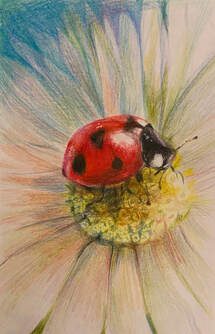Copyright when drawing from a photo onlineLike any other item that can be protected by copyright, a work of art is protected by copyright if it is attached in a tangible form (such as a painting, sculpture, or drawing). When I teach students, I often find them complaining of stress about imagining and drawing things they cannot see. This is very natural. Even well-trained artists find it difficult to draw what they can't see. So, I sometimes look at photos and draw for reference about certain movements or special situations. This is true for artists, but young students will face even greater difficulties. So I search the Internet, look at photos or other people's drawings, and draw. Of course, this is okay when practicing. In fact, my drawing skills improve a lot by imitating other artists’ paintings. But what if you were trying to sell a painting or entered a contest? In these cases, we face the issue of copyright. If we want to draw from a photo, we must first find out who took it and if it has copyright on it. Therefore, if you can't find out who created it, don't use it. You cannot take someone's photo and draw straight from it, especially if it has copyright. Copyright protects an author's original work that is "fixed" by permanent or semi-permanent means. Therefore, if you want to view, draw or use a copyrighted photo or illustration, you must obtain permission from the author. The scope of copyright gives people a lot of confusion. So, we looked into what falls under the scope of copyright. What is protected by copyright? Copyright law protects original works of authorship that are fixed in a tangible medium of expression. This includes literary works, music, paintings, photographs, and more. Essentially, it covers any creative expression that is captured in a physical or digital form. The concept of "Fair Use": Copyright law also includes the concept of "fair use," which allows limited use of copyrighted material without permission for purposes like criticism, commentary, news reporting, education, and research. However, there are specific guidelines and limitations on what qualifies as fair use, and it's a complex and often subjective area of law. Generally, using copyrighted material for commercial purposes, like selling your artwork, is less likely to qualify as fair use. Using reference materials: When you use copyrighted photographs or other visual materials as references for your artwork, it can potentially infringe on the original creator's copyright. This is especially true if you're creating artwork for commercial purposes. To address this, you should ideally seek permission from the copyright holder to use their work as a reference. This may involve obtaining a license or paying a fee. Derivative works: Creating derivative works, like a painting based on a copyrighted photograph, is another aspect to consider. In some cases, you may be able to create derivative works if you have the appropriate permissions. However, simply imitating another artist's work closely, even without direct copying, can sometimes raise copyright concerns. Public domain and Creative Commons: Some works are in the public domain, which means they are not protected by copyright and can be freely used. Additionally, some creators offer their work under licenses like Creative Commons, which specify how their work can be used with certain conditions. Obtaining permission: If you want to use copyrighted material as a reference for your artwork in a way that doesn't fall under fair use, it's best to contact the copyright holder to seek permission. This could involve reaching out to the photographer or illustrator and negotiating the terms, including any fees or royalties. Documentation: When using reference materials, especially if you have obtained permission, it's a good practice to document and credit the original source. This not only gives proper recognition to the original creator but can also serve as evidence of your good faith efforts to comply with copyright law. It's essential to be aware of copyright laws and their implications, especially when creating and selling artwork. When in doubt, seeking legal advice from an intellectual property attorney is advisable to ensure that you are complying with copyright regulations while pursuing your artistic endeavors. HOW DO I KNOW IF MY WORK IS ORIGINAL? An original work is one that is new and different from what others have created. This means that you are the author of the work, and the work is not copied from someone else’s original work. Even if there is no exact or literal copying, but the average person may notice substantial similarities between the entered work and the source material, it is possible that the work will not be considered original and should not be entered into the Awards. At this time, we do not consider any work you create using AI tools or that incorporates content generated by AI tools to be your original work. We understand that artists and writers sometimes create work that references other artists, writers, and popular culture in original and meaningful ways. If your work transforms some sort of source material, then it may be considered original. We define transformative work as a new work that adds value, substantially changes, comments on, or gives a new expression or meaning to the source. If the entry uses another artist or writer’s work as raw material and transforms the original work by bringing new insights and understandings to the piece, it may be entered into the Scholastic Awards. Here are some examples of work that should not be entered:
The easiest solution to avoiding copyright infringement when painting from photos is to take your own photos. Not only do you not run any risk whatsoever of copyright infringement, but you have complete creative control over the entire artistic process, which can only benefit your art-making and painting.
0 Comments
Leave a Reply. |
Myungja Anna KohArtist Categories
All
Archives
July 2024
|
Proudly powered by Weebly


 RSS Feed
RSS Feed